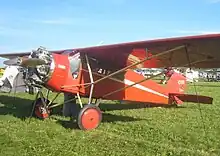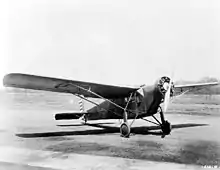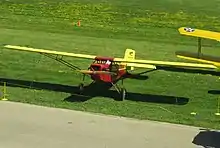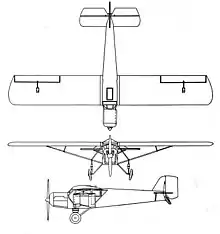Curtiss Robin
The Curtiss Robin, introduced in 1928, was a high-wing monoplane built by the Curtiss-Robertson Airplane Manufacturing Company. The J-1 version was flown by Wrongway Corrigan who crossed the Atlantic after being refused permission.
| Curtiss Robin | |
|---|---|
 | |
| A Curtiss Robin in the Seattle museum of flight, 2011 | |
| Role | Touring |
| Manufacturer | Curtiss-Robertson Airplane Manufacturing Company |
| First flight | 7 August 1928[1] |
| Introduction | 1928 |
| Status | A number still flying[1] |
| Primary user | U. S. Private Owner Market[1] |
| Number built | 769[1] |
Design
The Robin, a workmanlike cabin monoplane, had a wooden wing and steel tubing fuselage. The cabin accommodated three persons; two passengers were seated side-by-side behind the pilot. Early Robins were distinguished by large flat fairings over the parallel diagonal wing bracing struts; the fairings were abandoned on later versions, having been found to be ineffective in creating lift.[1] The original landing gear had bungee rubber cord shock absorbers, later replaced by an oleo-pneumatic system; a number of Robins had twin floats added.[2] Variants of the Robin were fitted with engines which developed 90–185 hp (67–138 kW).[2]
Operational history

A single modified Robin (with a 110 hp (82 kW) Warner R-420-1) was used by the United States Army Air Corps, and designated the XC-10. This aircraft was used in a test program for radio-controlled (and unmanned) flight.[2]
Cuba's national airline, Compañía Nacional Cubana de Aviación Curtiss, was founded in 1929 with the Curtiss-Wright company serving as its co-founder and major investor. The airline's first aircraft was a Curtiss Robin and it was flown on domestic routes as a mail and passenger transport.
From September 1929 to May 1930 a Robin C-1 was used to deliver the McCook, Nebraska Daily Gazette to communities in rural Nebraska and Kansas. The airplane flew a nonstop route of 380 miles (610 km) daily, dropping bundles of newspapers from a height of 500 feet (150 m) to local carriers.[3]
A Curtiss Robin C was purchased by the Paraguayan government in 1932 for the transport squadron of its air arm. It was intensively used as a VIP transport plane and air ambulance during the Chaco War (1932–1935).
Variants (Model 50)
Data from:Curtiss aircraft : 1907-1947[2]
- Challenger Robin
- (Model 50A) An early version of the Robin, powered by a 165 hp (123 kW) Curtiss Challenger radial piston engine.
- Comet Robin
- One Robin was converted by its owner in 1937, fitted with a 150 hp (110 kW) Comet 7-D radial piston engine.
- Robin
- (Model 50A) Prototypes and initial production aircraft powered by 90 hp (67 kW) Curtiss OX-5 engines.
- Robin B
- A three-seat cabin monoplane, fitted with wheel brakes and a steerable tailwheel, powered by a 90 hp (67 kW) Curtiss OX-5 V-8 engine; about 325 were built.
- Robin B-2
- A three-seat cabin monoplane, powered by a 150–180 hp (110–130 kW) Wright-Hisso "A","E" and "I" V-8 water-cooled piston engine.
- Robin C
- A three-seat cabin monoplane, powered by a 170 hp (130 kW) or 185 hp (138 kW) Curtiss Challenger radial piston engine; about 50 built.

- Robin C-1
- (Model 50C) An improved version of the Robin C, powered by a 185 hp (138 kW) Curtiss Challenger radial piston engine; over 200 built.
- Robin C-2
- (Model 50D) A long-range version fitted with an extra fuel tank, powered by a 170 hp (130 kW) Curtiss Challenger radial piston engine; six built.
- Robin 4C
- (Model 50E) A four-seat version, powered by a Curtiss Challenger radial piston engine; one built.
- Robin 4C-1
- A three-seat version with an enlarged forward fuselage section; three built.
- Robin 4C-1A
- (Model 50G) Another four-seat version with an enlarged forward fuselage section; 11 built.
- Robin 4C-2
- A single un-certified version powered by a 225 hp (168 kW) Wright J-6-7 Whirlwind engine.
- Robin CR
- A one-off experimental version, fitted with a 120 hp (89 kW) Curtiss Crusader engine.
- Robin J-1
- (Model 50H) Powered by a 165 hp (123 kW) Wright J-6-5 Whirlwind radial piston engine; about 40 built.
- Robin J-2
- (Model 50I) A long-range version, with 80 US gal (67 imp gal; 300 L) fuel. Two were built
- Robin J-3
- A J-1 temporarily designated J-3, which reverted to the J-1 designation after being de-modified.
- Robin M
- A Robin B aircraft, fitted with the 115 hp (86 kW) Milwaukee Tank V-502 V-8 engine (air-cooled OX-5 conversions).
- Robin W
- (Model 50J) Powered by a 110 hp (82 kW) Warner Scarab radial piston engine. Only a small number were built in 1930.

- XC-10
- One Robin W was sold to the United States Army Air Corps (USAAC) and converted into an unmanned pilot-less radio-controlled test aircraft, powered by a 110 hp (82 kW) Warner R-420-1.
Operators
Surviving aircraft

Australia
- 477 – J-1 airworthy with John Graeme Vevers of Patterson Lakes, Victoria.[4]
Brazil
- 248 – C-2 in storage at the TAM Museum in São Carlos, São Paulo.[5]
Canada
- 405 – C-1 on display at the Reynolds-Alberta Museum in Wetaskiwin, Alberta.[6]
Costa Rica
- C-1 on display at the Juan Santamaría International Airport domestic terminal in Alajuela, Costa Rica.
Germany
- 130 – J-1 airworthy with Antique Aeroflyers in Mengen, Baden-Württemberg.[7][8]
United States
.jpg.webp)
- 193 – B airworthy at the Fantasy of Flight in Polk City, Florida.[9][10][11]
- 213 – B airworthy at the Western Antique Aeroplane & Automobile Museum in Hood River, Oregon.[12][13]
- 329 – B-1 on static display at the San Diego Air & Space Museum in San Diego, California.[14]
- 337 – C-1 on static display at the Evergreen Aviation & Space Museum in McMinnville, Oregon.[15][16][17]
- 403 – B-2 on display at the EAA Aviation Museum in Oshkosh, Wisconsin.[18][19]
- 469 – C-1 on display at the Yanks Air Museum in Chino, California.[20][21]
- 628 – C-1 on static display at the Museum of Flight in Seattle, Washington.[22]
- 712 – 4C-1A on display at the Western North Carolina Air Museum in Hendersonville, North Carolina.[23][24]
- 733 – J-1D on display at the Shannon Air Museum in Fredericksburg, Virginia.[25][26] It was previously on display at the Virginia Aviation Museum.[27]
- 737 – J-1 airworthy with Brian T. Coughlin of Cazenovia, New York.[28] It is based at Old Rhinebeck Aerodrome.
- J-1 Ole Miss (US registration NR526N) on static display at the National Air and Space Museum in Washington, D.C. that set the aviation endurance record in 1935 (continuously airborne June 4-July 1), which it held for 4 years.[29]
- On static display at the Cradle of Aviation Museum in Garden City, New York. It has floats in place of wheeled landing gear.[30]
- On display at the Air Zoo in Portage, Michigan.[31][32][33]
- On display at the Eagles Mere Air Museum in Eagles Mere, Pennsylvania.[34]
- On static display at the Glenn H. Curtiss Museum in Hammondsport, New York.[35]
- On display at the Historic Aircraft Restoration Museum in Maryland Heights, Missouri.[36]
- Under restoration at the Candler Field Museum in Williamson, Georgia.[37] Now owned and operated by Capt. Buerk’s Living History Museum in New Hampshire.
- Under restoration at the Port Townsend Aero Museum in Port Townsend, Washington.[38]
Specifications (Robin OX-5)

Data from Curtiss Aircraft 1907–1947,[2] Jane's all the World's Aircraft 1928[39]
General characteristics
- Crew: 1
- Capacity: 2 pax / 425 lb (193 kg) payload
- Length: 25 ft 9 in (7.85 m)
- Wingspan: 41 ft 0 in (12.5 m)
- Height: 7 ft 10 in (2.4 m)
- Wing area: 262.5 sq ft (24.39 m2)
- Airfoil: Curtiss C-72[40]
- Empty weight: 1,475 lb (669 kg)
- Max takeoff weight: 2,175 lb (987 kg)
- Fuel capacity: 50 US gal (42 imp gal; 190 L) fuel; 5 US gal (4.2 imp gal; 19 L) oil
- Powerplant: 1 × Curtiss OX-5 V-8 water-cooled piston engine, 90 hp (67 kW)
- Propellers: 2-bladed fixed pitch propeller
Performance
- Maximum speed: 99.7 mph (160.5 km/h, 86.6 kn)
- Cruise speed: 85 mph (137 km/h, 74 kn)
- Landing speed: 45 mph (39 kn; 72 km/h)
- Range: 785 mi (1,263 km, 682 nmi) cruising; 580 mi (500 nmi; 930 km) at full throttle
- Service ceiling: 12,500 ft (3,800 m)
- Rate of climb: 450 ft/min (2.3 m/s)
- Time to altitude: 3,800 ft (1,200 m) in 10 minutes
- Wing loading: 8.2 lb/sq ft (40 kg/m2)
- Power/mass: 0.0465 hp/lb (0.0764 kW/kg)
See also
Related development
Related lists
References
- Eden, Paul; Moeng, Soph (2002). The complete encyclopedia of world aircraft. New York, NY: Barnes & Noble Books. ISBN 0-7607-3432-1.
- Bowers, Peter M. (1979). Curtiss aircraft : 1907-1947. London: Putnam. pp. 172, 377–86. ISBN 0-370-10029-8.
- "Curtiss-Robertson Robin C-1". www.museumofflight.org. Museum of flight. Retrieved 16 February 2018.
- "Aircraft Register Search [VH-JUV]". Australian Government Civil Aviation Safety Authority. Retrieved 30 July 2018.
- "Airframe Dossier - CurtissB Robin, s/n R-204 FAA, c/n 248, c/r LV-FAV". Aerial Visuals. AerialVisuals.ca. Retrieved 30 July 2018.
- "Aviation". Reynolds Museum. Retrieved 14 June 2020.
- "Curtiss Robin J-1". Antique Aeroflyers (in German). 28 February 2013. Retrieved 30 July 2018.
- "FAA REGISTRY [N292E]". Federal Aviation Administration. U.S. Department of Transportation. Retrieved 30 July 2018.
- "1929 Curtiss Robin". Fantasy of Flight. Fantasy of Flight. Retrieved 30 July 2018.
- "Airframe Dossier - Curtiss B Robin, c/n 193, c/r N8313". Aerial Visuals. AerialVisuals.ca. Retrieved 30 July 2018.
- "FAA REGISTRY [N8313]". Federal Aviation Administration. U.S. Department of Transportation. Retrieved 30 July 2018.
- "Curtiss Robertson Robin B". Western Antique Aeroplane & Automobile Museum. WAAAM. Retrieved 30 July 2018.
- "FAA REGISTRY [N8332]". Federal Aviation Administration. U.S. Department of Transportation. Retrieved 30 July 2018.
- "Curtiss B-1 Robin". San Diego Air & Space Museum. Retrieved 31 July 2018.
- "General Aviation". Evergreen Aviation & Space Museum. Evergreen Museum. Retrieved 30 July 2018.
- "Airframe Dossier - Curtiss C-1 Robin, c/r NC9283". Aerial Visuals. AerialVisuals.ca. Retrieved 30 July 2018.
- "FAA REGISTRY [N9283]". Federal Aviation Administration. U.S. Department of Transportation. Retrieved 30 July 2018.
- "1929 Curtiss-Wright Model B-2 Robin - N50H". EAA. EAA. Retrieved 30 July 2018.
- "FAA REGISTRY [N50H]". Federal Aviation Administration. U.S. Department of Transportation. Retrieved 30 July 2018.
- "Curtiss C-1 Robin". Yanks Air Museum. Yanks Air Museum. Retrieved 30 July 2018.
- "FAA REGISTRY [N3865B]". Federal Aviation Administration. U.S. Department of Transportation. Retrieved 30 July 2018.
- "Curtiss-Robertson Robin C-1". The Museum of Flight. The Museum of Flight. Retrieved 31 July 2018.
- "1930 CURTISS ROBIN 4C-1A". Western North Carolina Air Museum. Western North Carolina Air Museum. Retrieved 30 July 2018.
- "FAA REGISTRY [N563N]". Federal Aviation Administration. U.S. Department of Transportation. Retrieved 30 July 2018.
- Sullivan, Paul (15 November 2016). "Antique planes and other items coming home to Shannon Airport". Fredericksburg.com. BH Media Group, Inc. Retrieved 31 July 2018.
- "FAA REGISTRY [N532N]". Federal Aviation Administration. U.S. Department of Transportation. Retrieved 31 July 2018.
- "Virginia Aviation Museum Historic Aircraft" (PDF). Virginia Aviation Museum. Virginia Aviation Museum. Archived from the original (PDF) on 12 May 2016. Retrieved 31 July 2018.
- "FAA REGISTRY [N534N]". Federal Aviation Administration. U.S. Department of Transportation. Retrieved 30 July 2018.
- "Curtiss Robin J-1 Deluxe "Ole Miss"". Smithsonian National Air and Space Museum. Smithsonian Institution. Retrieved 30 July 2018.
- Stoff, Joshua (2001). The Historic Aircraft and Spacecraft in the Cradle of Aviation Museum. Mineola, New York: Dover Publications. p. 23.
- "East Campus Aircraft". Air Zoo. Air Zoo. Archived from the original on 31 July 2018. Retrieved 30 July 2018.
- "FAA REGISTRY [N7912]". Federal Aviation Administration. U.S. Department of Transportation. Retrieved 30 July 2018.
- Zerilli, Ursula (4 October 2012). "Air Zoo acquires 1928 Curtiss Robin high-wing monoplane". MLive. Advance Local Media LLC. Retrieved 30 July 2018.
- "1928 Curtiss Robin". Eagles Mere Air Museum. Eagles Mere Air Museum. Archived from the original on 12 October 2017. Retrieved 31 July 2018.
- "Aircraft". Glenn H. Curtiss Museum. Glenn H. Curtiss Museum. Retrieved 31 July 2018.
- "Museum Hangar 2". Historic Aircraft Restoration Museum. Historic Aircraft Restoration Museum. Retrieved 31 July 2018.
- "Candler Field Museum". Peach State Aerodrome. Peach State Aerodrome. Retrieved 31 July 2018.
- "1929 Curtiss "Robin"". Port Townsend Aero Museum. Archived from the original on 18 July 2015. Retrieved 31 July 2018.
- Grey, C.G., ed. (1928). Jane's all the World's Aircraft 1928. London: Sampson Low, Marston & company, ltd. pp. 18d–19d.
- Lednicer, David. "The Incomplete Guide to Airfoil Usage". m-selig.ae.illinois.edu. Retrieved 16 April 2019.
Bibliography
- Hagedorn, Dan (March–May 1992). "Curtiss Types in Latin America". Air Enthusiast. No. 45. pp. 61–77. ISSN 0143-5450.